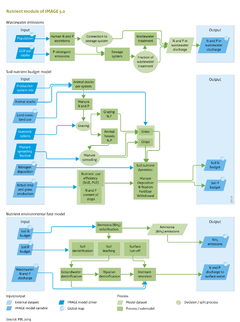Nutrients/Policy issues: Difference between revisions
Jump to navigation
Jump to search
Oostenrijr (talk | contribs) No edit summary |
Oostenrijr (talk | contribs) m (Text replace - "NH3" to "NH<sub>3</sub>") |
||
| Line 14: | Line 14: | ||
* Extensification (EX), assuming for example that 10% of ruminant production in mixed and industrial systems shifts to pastoral production systems. | * Extensification (EX), assuming for example that 10% of ruminant production in mixed and industrial systems shifts to pastoral production systems. | ||
* Increased feed conversion efficiency (FE), assuming for example 10% reduction in N and P excretion for cattle, pigs, poultry and small ruminants in mixed and industrial systems. This is achieved by increasing the use of concentrates. | * Increased feed conversion efficiency (FE), assuming for example 10% reduction in N and P excretion for cattle, pigs, poultry and small ruminants in mixed and industrial systems. This is achieved by increasing the use of concentrates. | ||
* Improved manure storage systems (ST), considering for example 20% lower | * Improved manure storage systems (ST), considering for example 20% lower NH<sub>3</sub> emissions from animal housing and storage systems. This means that the animal manure used for spreading contains 5% more N than under the baseline scenario. | ||
* Integrated manure management (IM) where, for example, all manure under the baseline scenario ends up outside the agricultural system (e.g., manure used as fuel, see the figure above) and is recycled in crop systems to substitute fertiliser. In addition, integration of animal manure in crop systems is improved, particularly in industrialised countries. | * Integrated manure management (IM) where, for example, all manure under the baseline scenario ends up outside the agricultural system (e.g., manure used as fuel, see the figure above) and is recycled in crop systems to substitute fertiliser. In addition, integration of animal manure in crop systems is improved, particularly in industrialised countries. | ||
* Dietary changes (DI), for example, assume that by 2050, 10% of beef consumption under the baseline scenarios is replaced by poultry meat in all producing regions, without accounting for changes in agricultural trade. | * Dietary changes (DI), for example, assume that by 2050, 10% of beef consumption under the baseline scenarios is replaced by poultry meat in all producing regions, without accounting for changes in agricultural trade. | ||
Revision as of 10:39, 1 July 2014
Parts of Nutrients/Policy issues
| Component is implemented in: |
| Components: |
| Related IMAGE components |
| Projects/Applications |
| Key publications |
